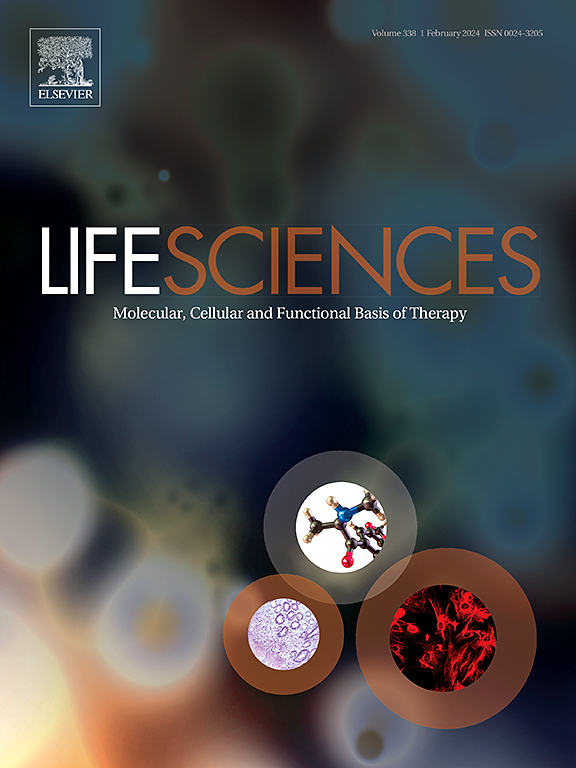METTL3-mediated m6A modification of FUNDC1/IP3R2 pathway facilitates cardiac hypertrophy in obesity hypertension
IF 5.1
2区 医学
Q1 MEDICINE, RESEARCH & EXPERIMENTAL
引用次数: 0
Abstract
Background
FUNDC1-mediated mitochondria-associated endoplasmic reticulum membrane (MAM) Ca2+ conduction is crucial in cardiac hypertrophy. N6-methyladenosine (m6A) methylation, a crucial mRNA modification, is implicated in this process. We hypothesise that m6A regulation of FUNDC1-mediated MAM-associated Ca2+ overload contributes to obesity hypertension (OBH) cardiac hypertrophy.
Methods
We investigated OBH in spontaneously hypertensive rats fed a high-fat diet, with WKY rats as controls. Assessments included blood pressure, cardiac hypertrophy, pyroptosis, protein expression of MAM-related (FUNDC1, IP3R2) and m6A-related gene (METTL3, IGF2BP2). MeRIP assay detected m6A methylation in mRNA. We also examined cardiomyocyte morphology, viability, mitochondrial function (mtROS, SOD, MDA and ATP levels), and expression of pyroptosis-related factors (IL-1β, IL-18, NLRP3, GSDMD-N and Caspase-1/p10) in vitro. Silencing and overexpression of FUNDC1 and METTL3 clarified MAM effects on cardiac hypertrophy. FUNDC1 and IP3R2 interaction was assessed by co-immunoprecipitation.
Results
OBH rats exhibited significantly elevated blood pressure, cardiac hypertrophy, MAM dysfunction, elevated FUNDC1, IP3R2 and METTL3 expression, and pyroptosis. Ang II treatment in vitro upregulated FUNDC1, causing mitochondrial dysfunction, inflammation and pyroptosis in cardiomyocytes. FUNDC1 knockdown improved cardiomyocyte morphology and function, reduced mitochondrial Ca2+ concentration, enhanced mitochondrial function and attenuated pyroptosis while increasing IP3R2 ubiquitination. Mito Tempo reversed cardiomyocyte hypertrophy, mitochondrial dysfunction, inflammatory response and pyroptosis induced by FUNDC1 overexpression. Additionally silencing METTL3 and IGF2BP2 reduced m6A methylation of FUNDC1, inhibiting its expression.
Conclusion
METTL3 regulates FUNDC1 m6A methylation modification via IGF2BP2, thereby affecting FUNDC1 expression. FUNDC1 binding to IP3R2 regulates MAM-associated Ca2+ overload, inducing mitochondrial dysfunction and pyroptosis, leading to cardiac hypertrophy in OBH.

mettl3介导的m6A修饰FUNDC1/IP3R2通路促进肥胖高血压患者心脏肥厚。
背景:fundc1介导的线粒体相关内质网膜(MAM) Ca2+传导在心脏肥厚中是至关重要的。n6 -甲基腺苷(m6A)甲基化是一种重要的mRNA修饰,参与了这一过程。我们假设m6A调节fundc1介导的mam相关Ca2+超载有助于肥胖高血压(OBH)心脏肥厚。方法:以WKY大鼠为对照,观察高脂饮食对自发性高血压大鼠OBH的影响。评估包括血压、心脏肥厚、焦亡、mam相关(FUNDC1、IP3R2)和m6a相关基因(METTL3、IGF2BP2)的蛋白表达。MeRIP检测mRNA中m6A甲基化。我们还在体外检测了心肌细胞形态、活力、线粒体功能(mtROS、SOD、MDA和ATP水平)以及焦热相关因子(IL-1β、IL-18、NLRP3、GSDMD-N和Caspase-1/p10)的表达。沉默和过表达FUNDC1和METTL3阐明了MAM对心肌肥厚的影响。通过共免疫沉淀法评估FUNDC1和IP3R2的相互作用。结果:OBH大鼠表现为血压升高、心肌肥厚、MAM功能障碍、FUNDC1、IP3R2和METTL3表达升高、焦亡。Ang II体外处理上调FUNDC1,导致心肌细胞线粒体功能障碍、炎症和焦亡。FUNDC1敲低可改善心肌细胞形态和功能,降低线粒体Ca2+浓度,增强线粒体功能,减轻焦亡,同时增加IP3R2泛素化。Mito Tempo逆转了FUNDC1过表达引起的心肌细胞肥大、线粒体功能障碍、炎症反应和恶病质。此外,沉默METTL3和IGF2BP2可降低FUNDC1的m6A甲基化,抑制其表达。结论:METTL3通过IGF2BP2调控FUNDC1 m6A甲基化修饰,从而影响FUNDC1的表达。FUNDC1结合IP3R2调节mam相关的Ca2+超载,诱导线粒体功能障碍和焦亡,导致OBH的心脏肥大。
本文章由计算机程序翻译,如有差异,请以英文原文为准。
求助全文
约1分钟内获得全文
求助全文
来源期刊

Life sciences
医学-药学
CiteScore
12.20
自引率
1.60%
发文量
841
审稿时长
6 months
期刊介绍:
Life Sciences is an international journal publishing articles that emphasize the molecular, cellular, and functional basis of therapy. The journal emphasizes the understanding of mechanism that is relevant to all aspects of human disease and translation to patients. All articles are rigorously reviewed.
The Journal favors publication of full-length papers where modern scientific technologies are used to explain molecular, cellular and physiological mechanisms. Articles that merely report observations are rarely accepted. Recommendations from the Declaration of Helsinki or NIH guidelines for care and use of laboratory animals must be adhered to. Articles should be written at a level accessible to readers who are non-specialists in the topic of the article themselves, but who are interested in the research. The Journal welcomes reviews on topics of wide interest to investigators in the life sciences. We particularly encourage submission of brief, focused reviews containing high-quality artwork and require the use of mechanistic summary diagrams.
 求助内容:
求助内容: 应助结果提醒方式:
应助结果提醒方式:


